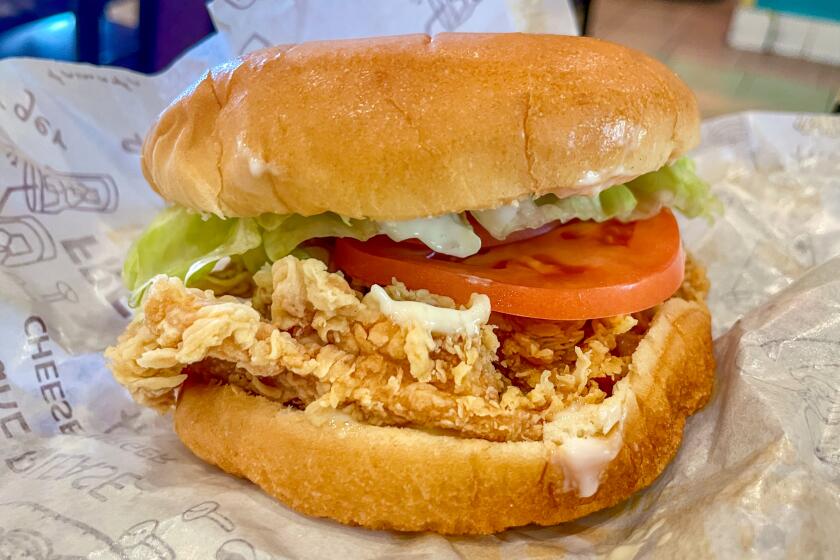Ever heard of Chinese hamburgers? Here’s where to try the world’s oldest sandwich

- Share via
- Rou jia mo is a dish from the Shaanxi province in China often called a Chinese hamburger.
- It’s gaining in popularity in the U.S. thanks to restaurants like Xi’an Famous Foods in New York and Bang Bang Noodles in Los Angeles.
- The sandwich can be found with a variety of fillings including braised pork, beef and lamb.
Rou jia mo can be an unlovely thing, uncouth as a sloppy Joe and as decadent and satisfying as your favorite steakhouse burger. Sometimes called a Chinese hamburger, when done well, it’s one of the greatest meat-between-bread situations in the universe.
It involves a split round bread bun with a meat filling that spills from the middle. It’s commonly made with braised pork belly, but you’ll find variations filled with lamb spiced heavily with cumin and also beef.
Many credit rou jia mo as the world’s oldest sandwich, originating in the Shaanxi province in north-central China more than 2,000 years ago. Its capital Xi’an was where the Silk Road began, a trade epicenter that brought an influx of different cultures, foods and customs through the city.
Guan tang bao soup dumplings are the word-of-mouth draw at a new Rosemead restaurant from the owners of Ji Rong Peking Duck around the corner.
You can find the sandwiches all over the streets of Xi’an, and throughout China, but rou jia mo is steadily gaining in popularity and availability in the U.S., thanks to restaurants like Xi’an Famous Foods in New York City.
In his cookbook “Xi’an Famous Foods: The Cuisine of Western China, From New York’s Favorite Noodle Shop,” owner and author Jason Wang describes the dish as “an English muffin-like bun stuffed full of fatty soy-braised pork.” He grew up eating rou jia mo as an afternoon snack.

In Los Angeles, a growing number of restaurants in the San Gabriel Valley make rou jia mo, with styles that reflect regional versions made throughout China.
At Bang Bang Noodles, executive chef Robert Lee is making his interpretation of the pork-filled rou jia mo found all over Xi’an. The noodle shop, which started as a pop-up, and now has locations in both Culver City and downtown Los Angeles, specializes in biang biang noodles inspired by the thick, chewy noodles Xi’an is know for.
Lee’s rou jia mo begins with a semi-fermented, white flatbread called bai ji mo. It’s thin and crisp along its edges and soft and fluffy in the middle. He fills the bun with a braised pork belly he marinates overnight with soy sauce and a secret blend of herbs and spices that includes star anise and Sichuan peppercorns. The whole pork bellies are braised in a pot on the stovetop for around three hours.
The meat is roughly chopped with the skin on, giving each inch of the burger its own medley of textures. Slivers of green peppers are crunchy and fresh, tangled throughout the filling with a heap of cilantro.
What’s a chicken burger? And why are they popping up all over the San Gabriel Valley?
Lee added rou jia mo to his menu last summer, wanting to introduce Los Angeles diners to a summertime food pairing that’s popular in Xi’an.
“I wanted to stay true with the cuisine and give you a pairing of the cold noodle dish liang pi zi, rou jia mo and an orange soda,” Lee says.
Now, in the middle of winter, the cold noodles are no longer available. But the rou jia mo is the ideal sidekick to a bowl of Lee’s vinegar and chile-slicked hand-pulled noodles.

XiAn Biang Biang Noodle in San Gabriel is another restaurant that specializes in the foods of Xi’an. The restaurant offers a sturdy, bready bai ji mo filled with your choice of pork, beef or lamb. During multiple visits, the spicy lamb emerged the clear favorite, with chunks of tender meat stewed with green peppers and onion in a spicy chile sauce heavy on the cumin with a mala kick.
Offering an alternate style of rou jia mo is Good Alley, a dumpling-centric restaurant that opened in a Rosemead strip mall in September. Chef-owner Peter Pang swaps the bai ji mo for lao tongguan mo, wrapping his filling in a golden, layered pancake that flakes and shatters like a good croissant.
“The dough is made using high-gluten flour with a small amount of baking powder mixed in,” Pang says.
It undergoes three rounds of resting, is flattened, thinned, brushed with oil, rolled and cut to form its layered structure.

Pang uses the bread to nestle Kurobuta pork, A5 Miyazaki wagyu beef or cumin-spiked lamb. The wagyu is unsurprisingly the more decadent of the three, with cubes of beef that melt into the stewed peppers and onions. The effect of the flaky pastry and beef is similar to a Turkish meat-filled borek.
“We think the croissant-like crispy texture and rich aroma of meat are perfectly well-suited to the local tastes in Los Angeles,” Pang says. “The inspiration came from a visit to Da Don in Beijing many years ago. Their Peking duck was served with a smaller, crispy flatbread used to wrap the duck. This idea inspired us to incorporate a similar texture and flavor concept into our version of rou jia mo.”
On my last visit, my party ordered two rounds for the table. And it sparked a quest to find more rou jia mo made with the flakier style of bun.
I searched for the dish on Fantuan, a popular Asian food delivery app and came across a business called Joynees Boy Chinese Hamburger. It’s a small storefront in San Gabriel with a short menu of rou jia mo and noodles.
The Joynees Boy buns crackle like phyllo dough around a filling of pork or beef. The pork is moist and tender, with chopped and shredded bits reminiscent of good carnitas.

The beef is well-marbled and thinly sliced, a little on the drier side like deli roast beef.
Lee suspects rou jia mo isn’t as prevalent in the United States as some other Xi’an specialties due to how much work is involved in making both the filling and the buns. It may also have something to do with a lack of familiarity with the dish.
“People that want it and eat it are people who mainly grew up with it,” Lee says. “And the places that have it, especially mine, I’m not sure I’m promoting it as well as I should.”
Where to find rou jia mo in Los Angeles
Bang Bang Noodles, multiple locations at www.bangbangnoodlesla.com
XiAn Biang Biang Noodle, 1039 E Valley Blvd. Ste B102, San Gabriel, (626) 763-0980,
xianbiangbiangnoodle.com
Good Alley, 8450 E Valley Blvd #108, Rosemead, (626) 280-2800, www.good-alley.com
Joynees Boy Chinese Hamburger, 156 S. San Gabriel Blvd., San Gabriel, (626) 268-6768
More to Read
Eat your way across L.A.
Get our weekly Tasting Notes newsletter for reviews, news and more.
You may occasionally receive promotional content from the Los Angeles Times.













